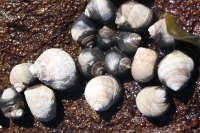
(Photo: Tracey Dean)
Common Periwinkle
Littorina littorea
This species is greyish brown to black, with dark bands. It has a heavy shell, with six to seven whorls and a columella with a white base. The shell has a sharp conical shape with a pointed apex and a sculptured surface.
Authority
Linnaeus, 1758
Classification Details
Phylum: Mollusca (molluscs); Class: Gastropoda (gastropod molluscs, or snails and slugs).
Habitat
Found throughout the North Atlantic; on North American coasts, its range extends from Labrador to Maryland. It is very abundant in the Bay of Fundy. It is an invasive species introduced to Canada around 1840 from Europe. Found from the high-water mark to depths of 40 metres. Habitat includes intertidal and shallow subtidal zones. It is tolerant of low salinities (13 parts per thousand) and found at the heads of estuaries.
Diet
An omnivore that feeds by grazing surfaces using its radula. This is a hard, ribbon-like structure with many tiny teeth that the periwinkle uses to tear up food and bring it into its mouth. It feeds on algae, juvenile invertebrates such as barnacle larvae, diatoms, and marsh grasses. It uses suspension or deposit feeding to consume planktonic and minute detrital food.
Reproduction
Sexes are separate; fertilization is internal. Temperature determines time and duration of breeding. Females reach sexual maturity at a shell height of 14 millimetres. They release egg capsules into the water from April to July. Each capsule contains two to three eggs, but can have up to nine. The capsules swell and burst after five or six days. After hatching, the larval phase lasts up to four weeks. Adults can live up to five years but average three.
Fun Facts
Another common name for this species is the "wrinkle winkle" - from the ridges in its shell.
This species is a popular food in Europe. They are often sold at the seaside: boiled in seawater and served in paper bags which have a pin attached for extracting the flesh from the shell. There is an open periwinkle fishery in the Bay of Fundy, which does not need a license.
References
CABI. Littorina littorea (common periwinkle) – Invasive Species Compendium. https://www.cabi.org/isc/datasheet/76460 Accessed online 22 January 2020.
DFO (1998) Periwinkle (Littorina littorea) DFO Science Stock Status Report, no. C3–46, 5pp.
Gordon J and Weeks TE (1982) Seashells of the Northeast Coast from Cape Hatteras to Newfoundland. Surrey: Hancock House Publishers.
Jackson A (2008) Littorina littorea Common periwinkle. In Tyler–Walters H. and Hiscock K. (eds) Marine Life Information Network: Biology and Sensitivity Key Information Reviews, [on–line]. Plymouth: Marine Biological Association of the United Kingdom. Available from: https://www.marlin.ac.uk/species/detail/1328 Accessed online 22 January 2020.
Van Guelpen L, Pohle G, Vanden Berghe E and Costello MJ (2005) Marine Species Registers for the North Atlantic Ocean. World Wide Web electronic publication. http://www.vliz.be/vmdcdata/narms/


